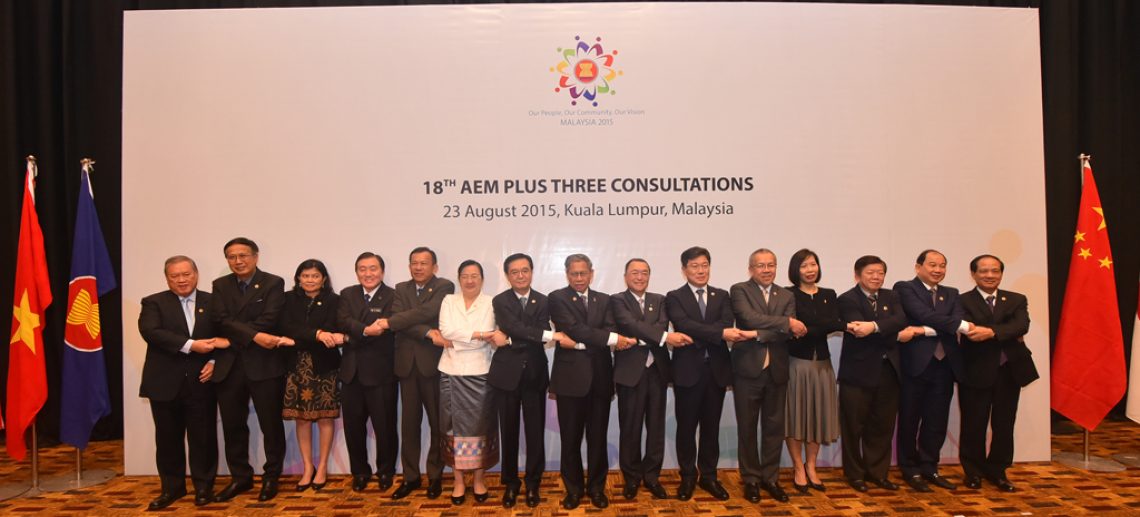1. Economic Ministers from the ten ASEAN Member States and Economic Ministers of People’s Republic of China (“China”), Japan, and Republic of Korea (“Korea”) met on 23 August 2015 in Kuala Lumpur, Malaysia for the Eighteenth AEM Plus Three Consultations. The Consultations were co-chaired by H.E. Dato’ Sri Mustapa Mohammed, Minister of International Trade and Industry, Malaysia, H.E. Gao Hucheng, Minister of Commerce of China, H.E. Yoichi Miyazawa, Minister of Economy, Trade, and Industry of Japan, and H.E. Yoon Sang-jick, Minister of Trade, Industry, and Energy of Korea.
2. The Ministers were pleased with trade performance in the region. According to ASEAN Statistics, total trade of ASEAN with Plus Three countries reached USD 727.1 billion in 2014, accounting for 28.8 per cent of total ASEAN trade. Foreign Direct Investment (FDI) inflow from Plus Three Countries in 2014 amounted to USD 26.7 billion.
3. The Ministers reiterated that collaboration between ASEAN and Plus Three Countries remained important to keep the economic foundation in the region strong, especially in light of recent global financial instability. The Ministers reaffirmed leaders’ statement that ASEAN Plus One Free Trade Agreements (FTA) with the Plus Three Countries would significantly contribute to enhancing the sustainability of the Micro, Small and Medium-sized Enterprises (MSMEs) in the region.
4. The Ministers expressed their appreciation to East Asia Business Council (EABC) for the continuous support to promote economic integration in the region. The Ministers noted the report by the EABC on the progress of its activities, and its submission of the recommendations which included, among others, supporting SMEs access to non-collateral financing; enabling SMEs access to project fund under the ASEAN Secretariat; promoting cross-border e-commerce in East Asia; and engaging stakeholders in RCEP negotiations and early conclusion thereof. The Ministers welcomed the inputs and looked forward to further inputs from the private sector to facilitate regional economic integration as envisaged under the RCEP.
Download the full Joint Statement here.
- ABOUT ASEANThe Association of Southeast Asian Nations, or ASEAN, was established on 8 August 1967 in Bangkok, Thailand, with the signing of the ASEAN Declaration (Bangkok Declaration) by the Founding Fathers of ASEAN: Indonesia, Malaysia, Philippines, Singapore and Thailand. Brunei Darussalam joined ASEAN on 7 January 1984, followed by Viet Nam on 28 July 1995, Lao PDR and Myanmar on 23 July 1997, and Cambodia on 30 April 1999, making up what is today the ten Member States of ASEAN.Menu
- WHAT WE DO
ASEAN organs always strive to achieve ASEAN’s goals and objectives, the Secretary-General of ASEAN and the ASEAN Secretariat shall be functioned as coordinating Secretariat to help facilitate effective decision-making withing and amongst ASEAN bodies. In addition, each Member State shall appoint a Permanent Representative to liaise with Secretary-General of ASEAN and the ASEAN Secretariat
Menu - WHO WE WORK WITH
ASEAN shall develop friendly relations and mutually beneficial dialogues, cooperation and partnerships with countries and sub-regional, regional and international organisations and institutions. This includes external partners, ASEAN entities, human rights bodies, non-ASEAN Member States Ambassadors to ASEAN, ASEAN committees in third countries and international organisations, as well as international / regional organisations.
Menu - OUR COMMUNITIES
The rodmap for an ASEAN Community (2009-2015) was declared by the leaders in 2009. The ASEAN Community, anchored on three community pillars: Political-Security Community, Economic Community, Socio-Cultural Community was launched in 2015. The ASEAN 2025: Forging Ahead Together was introduced in 2015 as a Post-2015 Vision. It comprises the ASEAN Community Vision 2025, the ASEAN Political-Security Community Blueprint 2025, the ASEAN Economic Community Blueprint 2025 and the ASEAN Socio-Cultural Community Blueprint 2025
Menu - SITEMAP





